Use the field list to view the list of fieldsets and fields that are available from the source data and to add fields to the row, column, filter, and detail areas of the PivotTable view. In the field list, the fields that are not bold are available but not yet displayed in the PivotTable view. The bold fields are already displayed. You can scroll and click the expand indicators ( or
or  boxes) next to the fieldsets to show or hide fields in the field list.
boxes) next to the fieldsets to show or hide fields in the field list.
The following illustration shows the Employees table in PivotTable view. The view shows details of employees in each city.

 City field is in the filter area.
City field is in the filter area.
 Title field is in the row area.
Title field is in the row area.
 Hire Date field is in the column area.
Hire Date field is in the column area.
 Last Name field is in the detail area.
Last Name field is in the detail area.
 Adding fields to the detail area
Adding fields to the detail area
Use detail fields to display detail data and see what data is available to be summarized. When you add fields to the detail area, you display all of the detail records from the source data for the fields. Field names become column labels, and the detail records are displayed in rows below the column labels.
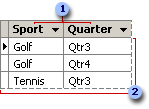
 Detail fields
Detail fields
 Detail data
Detail data
You can also add a calculated detail field that uses an expression to calculate detail values.
 Adding fields to the row or column area
Adding fields to the row or column area
Use row and column fields to summarize and compare data. These fields display the unique items of data within a field down rows or across columns. The cell at each row and column intersection summarizes the data for an item.
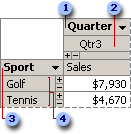
 Column field
Column field
 Column field item
Column field item
 Row field
Row field
 Row field items
Row field items
 Adding fields to the filter area
Adding fields to the filter area
Use a filter field to confine the view to a particular part of the available data. When you select an item in a filter field, data is displayed and calculated only for that item. For example, if you add a Region filter field, you can have the PivotTable view display and calculate data for the regions you select.
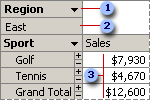
 Filter field
Filter field
 Filter field item
Filter field item
 Summary for the selected region
Summary for the selected region
You can create new fields by adding total fields to the PivotTable view. Total fields summarize detail data. For example, if the datasheet or form includes a Sales field that shows the amount of each sale, you could add a Sum of Sales total field to calculate the total sales, or a Count of Sales total field to calculate how many units were sold.
You can also add a calculated total field that uses an expression to calculate total values.
To eliminate data that you don't want to see or summarize in the view, you can remove fields from the PivotTable view layout. Removing a field does not remove it from the available source data. A field that you remove is no longer displayed in the PivotTable view, but it remains available in the field list for viewing.
After you add a field to a PivotTable view, you can move it to other areas. When you move a field, you change the layout of the PivotTable view, and you change the data that's displayed and the summaries that are calculated.
 Impact of adding and removing fields on filtering
Impact of adding and removing fields on filtering
Filter settings are retained when you remove a field. If you remove a field and later add the field back to the layout, the same items are again hidden.
 Impact of your changes on PivotChart view
Impact of your changes on PivotChart view
When you add, move, or remove fields in PivotTable view, Microsoft Access automatically updates the PivotChart view to reflect the change you made. For example, if you add a filter field to the PivotTable view, Access adds the field to the filter area in PivotChart view as well. Similarly, if you make a change in PivotChart view, Access will update the PivotTable view automatically. So, after you design the layout of one view and switch to the other view for the first time, you will not see a blank view.
Access does not synchronize formats between PivotTable and PivotChart views.
If you have made changes to the layout of a form in PivotTable or PivotChart view, Microsoft Access automatically saves your changes when you close the object. If you have made changes to the layout of a datasheet in one of these views, Access asks whether you want to save your changes before quitting.
Layout information is not stored separately for each user. For example, if another user opens a form in PivotChart view and makes changes to the layout, the next time you open the form in PivotChart or PivotTable view, you will see the layout as it was modified by the other user.
Use the field list to view the list of fieldsets and fields that are available from the source data and to add fields to the category, series, filter, and MultiChart areas of the PivotChart view. In the field list, the fields that are not bold are available but not yet displayed in the PivotChart view. The bold fields are already displayed. You can scroll and click the expand indicators ( or
or  boxes) next to the fieldsets to show or hide fields in the field list.
boxes) next to the fieldsets to show or hide fields in the field list.
You change the layout of a PivotChart view by moving the fields to predefined drop areas within the chart workspace. To do this, drop areas must be shown in the chart.
Drop areas are displayed differently depending on the chart type. For example, a series drop area is not displayed for a pie chart because pie charts consist of only one series. If you plot multiple charts, you will see a drop area for multi-chart fields. This type of drop area is not displayed for single charts.

After you move fields to the drop areas so that the drop-area captions are covered up, you can still drag additional fields to the areas.
 Moving fields to the category and series areas
Moving fields to the category and series areas
When you move a field to the series area, the unique items of data within the field are displayed as data series in the chart. These series are represented by colored data markers, and their names appear in the chart legend.
When you move a field to the category area, the unique items of data are displayed as categories, or related groups of data. Each category consists of one point from each data series. Category labels usually appear across the x axis of the chart, although this can vary depending on the type of chart you are using.
 Moving fields to the data area
Moving fields to the data area
Data fields provide the values to be summarized in the chart. When you move a field to the data area, the values from the field are used as the data that is measured in the chart.
 Moving fields to the filter area
Moving fields to the filter area
A filter field is similar to a page field in a Microsoft Excel PivotTable report. Filter fields allow you to confine the view to a particular part of the available data. For example, when you move a Product field to the filter area, you can have the chart display category and series values for one product at a time.
 Moving fields to the MultiChart area
Moving fields to the MultiChart area
When your chart is based on data from a PivotTable list or from a database table or query, you can plot multiple charts. When you move a field to the MultiChart area, items in that field become separate charts. For example, if you move the Salesperson field to the MultiChart area, a chart is created based on data for each salesperson in that field. In the following example, the Salesperson field is in the MultiChart area, but it's filtered so it displays individual charts for Buchanan and Davolio.
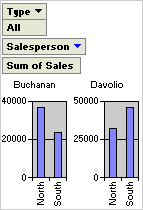
 Moving the category or series fields to inner or outer levels
Moving the category or series fields to inner or outer levels
When a chart contains multiple series or category fields, the fields that are closest to the data are referred to as inner fields. The other fields are outer fields. In the following example, Year is the outer field and Salesperson is the inner field. The inner field items are displayed as salespeople's names, and the outer field items are displayed as the years 1997 and 1998.
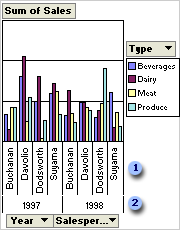
 Inner field items
Inner field items
 Outer field items
Outer field items
You can expand and collapse multiple fields to show more or less information in a particular field. For example, you can collapse the outer field (Year) in the example so that the inner field items are no longer displayed.
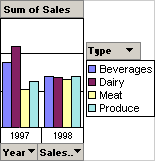
The layout of a chart does not have to include all fields that are available from the source data. If more data is available, you can add fields to the chart. For example, if the chart summarizes sales revenue, and the source data also includes sales quantities, you might add the Quantity field as a data field to summarize both revenue and quantity of products sold. You can also remove fields from the chart layout that you no longer want to see.
 Impact of changing layout on filtering
Impact of changing layout on filtering
Filter settings are retained when you move or remove a field. This means that when you move a series or category field to the filter area and back, previously hidden items are again hidden. If you remove a field and later add the field back to the layout, the same items are again hidden.